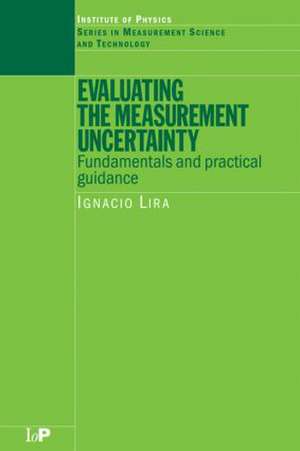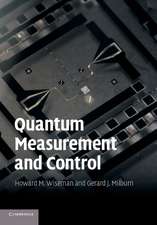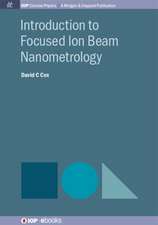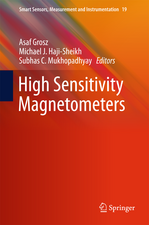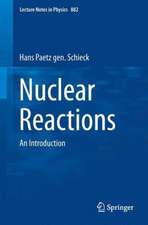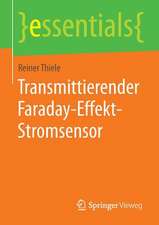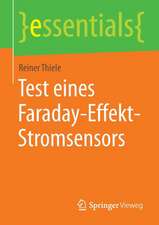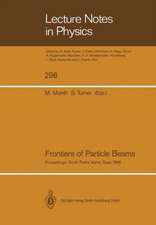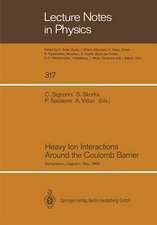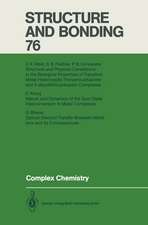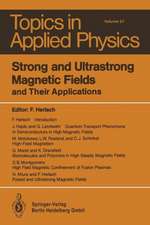Evaluating the Measurement Uncertainty: Fundamentals and Practical Guidance: Series in Measurement Science and Technology
Autor I Liraen Limba Engleză Hardback – 9 apr 2002
Evaluating the Measurement Uncertainty details the theoretical framework on which the GUM is based and provides additional material on more advanced topics such as least-squares adjustment and Bayesian statistics. The book does not require previous knowledge other than elementary calculus and can be read as a complement to the GUM or as a stand-alone reference source. It stresses fundamental principles and illustrates their applications through numerous examples taken from many different fields of metrology. The book includes practical guidance as well as theoretical aspects, resulting in an invaluable resource for metrologists, engineers, physicists, and graduate students involved with measurements in academia and industry.
Preț: 1390.04 lei
Preț vechi: 1695.17 lei
-18% Nou
Puncte Express: 2085
Preț estimativ în valută:
265.98€ • 278.45$ • 220.08£
265.98€ • 278.45$ • 220.08£
Carte tipărită la comandă
Livrare economică 07-21 aprilie
Preluare comenzi: 021 569.72.76
Specificații
ISBN-13: 9780750308403
ISBN-10: 0750308400
Pagini: 251
Dimensiuni: 156 x 234 x 19 mm
Greutate: 0.7 kg
Ediția:English.
Editura: CRC Press
Colecția CRC Press
Seria Series in Measurement Science and Technology
ISBN-10: 0750308400
Pagini: 251
Dimensiuni: 156 x 234 x 19 mm
Greutate: 0.7 kg
Ediția:English.
Editura: CRC Press
Colecția CRC Press
Seria Series in Measurement Science and Technology
Public țintă
ProfessionalRecenzii
"Evaluating the Measurement Uncertainty is a book written for anyone who makes and reports measurements. It attempts to fill the gaps left out of the ISO Guide to the Expression of Uncertainty in Measurement, or the GUM, and does a pretty thorough job. Evaluating … gives lots of explanations. It is well-written and makes use of many good figures and numerical examples. Also important, this book is written by a metrologist from a National Metrology Institute, and therefore up-to-date ISO rules, style conventions, and definitions are correctly used and supported throughout. The author sticks very closely to the GUM in topical theme and with frequent reference … I think this book is a fitting companion to the GUM because the text complements the GUM, from fundamental principles to more sophisticated measurement situations, and moreover includes intelligent discussion regarding intent and interpretation. Evaluating … is detailed, and I think most metrologists will really enjoy the detail and care put into this book."
-Dr. Jennifer Decker, Institute for National Measurement Standards, National Research Council Canada
"… this book certainly deserves careful consideration. If you go through it, you quickly realize that it is a multi-faceted book … it is also a rich collection of examples and sometimes of curiosities taken from a wide spectrum of specialized applications … the book represents a good tool for anybody wishing to understand better the topic of measurement uncertainty … I warmly recommend you to read and consider the contents of this book."
-Walter Bich, Measurement Science and Technology
"The book provides sound coverage … the treatment is clear and can be followed by readers with knowledge of basic algebra and elementary calculus … Practitioners who need to provide valid uncertainties and who wish to understand the science that underpins good practice in the area will benefit from this welcome book."
-Maurice Cox, Engineering Science and Education Journal, vol. 11, no. 5, October 2002
"[The book] is most welcome as a textbook intended to introduce the non-expert into the methods recommended by GUM … his book is certainly far more approachable than the document it seeks to elucidate, and is so far the only place for the uninitiated to start … any student who would like to understand those mysteries would do well to start here."
-Am J Phys, vol. 71, no. 1, January 2003
"The present book is one of the most comprehensive ones published so far … It is a valuable addition to the uncertainty literature and is useful for trainee metrologists as well as those having significant experience in the metrology field. In addition, personnel such as quality assurance officers and production engineers working in industry will also find the book useful."
-Dr. G.M.S de Silva, Measurement and Control, March 2003
"Lira presents a delightfully readable, though very mathematical, discussion using experimental examples, stepping through the statistical analysis … Any upper-level undergraduate science student will appreciate the explanations of the various measurement procedures and the application of statistical methods … This book brings together for the student as well as the researcher the statistical application to the 'bench work.' … This work helps the practitioner understand the process of measurement and the precision or uncertainty of those measurements. Upper-level undergraduates, graduate students, and researchers will find this book useful. Recommended for academic libraries."
-E-STREAMS, vol. 6, no. 1
"Ignacio Lira's book is a textbook presentation on how to handle uncertainty in measurement. It is intended both as a manual for self-study accessible to metrology students and as a complement to the authoritative ISO publication Guide to the Expression of Uncertainty in Measurement. The intended audience is varied, ranging from metrologists in national institutes and calibration laboratories through students and teachers of courses on quality, metrology, instrumentation, and related subjects to researchers carrying out experimental work in all fields of science and technology. Evaluating the Measurement Uncertainty could serve as a more rigorous companion text for advanced study and would enable the reader to gain an in-depth understanding of measurement uncertainty and to carry out detailed analysis of measurements."
-R.G. Cameron, Contemporary Physics 2003, 44(4)
-Dr. Jennifer Decker, Institute for National Measurement Standards, National Research Council Canada
"… this book certainly deserves careful consideration. If you go through it, you quickly realize that it is a multi-faceted book … it is also a rich collection of examples and sometimes of curiosities taken from a wide spectrum of specialized applications … the book represents a good tool for anybody wishing to understand better the topic of measurement uncertainty … I warmly recommend you to read and consider the contents of this book."
-Walter Bich, Measurement Science and Technology
"The book provides sound coverage … the treatment is clear and can be followed by readers with knowledge of basic algebra and elementary calculus … Practitioners who need to provide valid uncertainties and who wish to understand the science that underpins good practice in the area will benefit from this welcome book."
-Maurice Cox, Engineering Science and Education Journal, vol. 11, no. 5, October 2002
"[The book] is most welcome as a textbook intended to introduce the non-expert into the methods recommended by GUM … his book is certainly far more approachable than the document it seeks to elucidate, and is so far the only place for the uninitiated to start … any student who would like to understand those mysteries would do well to start here."
-Am J Phys, vol. 71, no. 1, January 2003
"The present book is one of the most comprehensive ones published so far … It is a valuable addition to the uncertainty literature and is useful for trainee metrologists as well as those having significant experience in the metrology field. In addition, personnel such as quality assurance officers and production engineers working in industry will also find the book useful."
-Dr. G.M.S de Silva, Measurement and Control, March 2003
"Lira presents a delightfully readable, though very mathematical, discussion using experimental examples, stepping through the statistical analysis … Any upper-level undergraduate science student will appreciate the explanations of the various measurement procedures and the application of statistical methods … This book brings together for the student as well as the researcher the statistical application to the 'bench work.' … This work helps the practitioner understand the process of measurement and the precision or uncertainty of those measurements. Upper-level undergraduates, graduate students, and researchers will find this book useful. Recommended for academic libraries."
-E-STREAMS, vol. 6, no. 1
"Ignacio Lira's book is a textbook presentation on how to handle uncertainty in measurement. It is intended both as a manual for self-study accessible to metrology students and as a complement to the authoritative ISO publication Guide to the Expression of Uncertainty in Measurement. The intended audience is varied, ranging from metrologists in national institutes and calibration laboratories through students and teachers of courses on quality, metrology, instrumentation, and related subjects to researchers carrying out experimental work in all fields of science and technology. Evaluating the Measurement Uncertainty could serve as a more rigorous companion text for advanced study and would enable the reader to gain an in-depth understanding of measurement uncertainty and to carry out detailed analysis of measurements."
-R.G. Cameron, Contemporary Physics 2003, 44(4)
Cuprins
Metrology, its role in today's world, Basic concepts and definitions, Evaluating the standard uncertainty, Evaluating the expanded uncertainty, The treatment of several measurands, Bayesian inference, Appendix: Probability tables, Glossary, References, Index
Descriere
Evaluating the Measurement Uncertainty details the theoretical framework on which the GUM is based and provides additional material on more advanced topics such as least-squares adjustment and Bayesian statistics. The book does not require previous knowledge other than elementary calculus and can be read as a complement to the GUM or as a stand-alone reference source. Including practical guidance as well as theoretical aspects, it stresses fundamental principles and illustrates their applications through numerous examples taken from many different fields of metrology.
